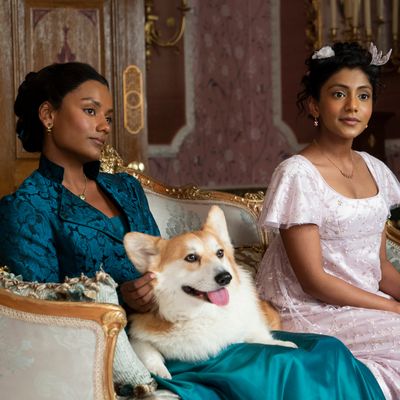
“Do you even know all the ways a lady can be seduced? The things I could teach you.” This line, delivered by Anthony Bridgerton to his love interest, Kate Sharma, has in recent days sent almost every woman I knew into an absolute tizzy.
Declared halfway through season two of Netflix’s Bridgerton, this sizzler did what the show has always done so well: Give women license to project themselves onto the character’s blushing, onscreen body, and in doing so allow them to feel seen.
As in its previous season, Bridgerton’s second run is fulfilling its romantic promise, and while it is delightful to watch women revel in these auditory thirst traps, it is the “feeling seen” part that deserves a closer look. As the new season welcomes characters from India into the Regency world, Kate’s presence serves dual roles: She is the general romance audience’s lusty liaison to Anthony, as well as the proxy by which South Asian women can participate in the Bridgerton world. This is the way diversity works the show — visually.
Bridgerton showrunner Chris Van Dusen maintains that it is more than that, positioning his characters of color as “color conscious,” which he defines “acknowledge[ing] the dimensions that race can bring to a story, and in most cases, embrac[ing] them.” Or, as Black actress Kathryn Drysdale, who plays Madame Delacroix on the show, told the Telegraph: “We’re not playing white or colorless characters. I am definitely playing a mixed-raced modiste.”
But in actual fact, Bridgerton’s casting practices fall more closely in line with that of colorblind casting, in which race is not written into the roles for which actors audition. The theory goes that the “best” person for the role will be selected based on their interpretation of the character. On its surface, this is an ideal practice for an industry still dominated by white decision-makers, but the problem is what happens after the person of color books the role. In order for anybody to be eligible to audition, these roles are written “normatively,” which often translates to white. Unless the writers adjust the character to the historical and cultural experiences associated with the actor, the result may be the equivalent of a white character dipped in chocolate or caramel.
Indeed, Bridgerton’s thinned notion of color consciousness only acknowledges racial difference in as much as it does not derail the story. The show has positioned itself as a kind of representational Switzerland — neither shying away from the fact that its characters of color are visibly different from their white counterparts, nor bringing to bear the ways in which their racial difference has historical implications. It’s a neutral-neutral racial positioning in an era of “representation matters,” in which feeling seen is only connected with aesthetics. Can you see your body type, skin tone, or hair texture on the screen? Good, our work here is done.
But it’s not, not really, especially since choices like these result in stereotypical pitfalls. Take, for example, season one’s Duke of Hastings, played by Black actor Regé-Jean Page. Hastings’s intentional lack of cultural specificity made it so that his persona as a cad devolved into a simple trope. The lack of context is especially harrowing when you consider the scene when his white love object, Daphne — brimming with curiosity and white innocence around sex — forces him to ejaculate inside her. This scene has since been critiqued as a rape, but it was also the moment Hastings is transformed into a stereotypical buck who breeds without his consent. With the complications of race, colonization, and chattel slavery rendered invisible in the world of Bridgerton, how were we to navigate the hypersexuality of Hastings when showrunners failed to acknowledge how black men’s bodies have been fetishized historically?
Season two’s addition of the Sharma family, meanwhile, illustrates the show’s desire to be coy about the place of Britain and colonization in a storyline that could have handled — even benefited — from some context. Instead, showrunners went so far as to hire a professor of history who could offer the writers a way to glaze over the East India Company’s complicated, violent, exploitative relationship between Britain and parts of India. Bridgerton also obscures the actual difficulty of intermarriage between white men and Indian women, which — due to the realities of colonization — did not occur often enough to suggest the ease with which a union between the Sharmas and the Bridergton family is assumed. “It was more common for men to return to England and settle down, leaving behind their children and the Indian women who’d given birth to them,” Cornell professor Durba Ghosh explained to the Los Angeles Times. And while a family like the Sharmas might have operated as peers with white families in the Regency era, the situation was exceedingly rare.
Of course, Bridgerton is fantasy. But works of fantasy can be a productive space for the working out of real social ills, and actually navigating the historical and cultural emergence of race in 19th-century Britain does not have to be avoided in service of fantastical pleasure. As it does the latter, Bridgerton operates as a revisionist fiction designed to provide maximum comfort to the audiences who need it the least.
Think what a show Bridgerton would be if its writers trusted their audience to hold both the pleasure of romance, and uncontrolled power of imperialism in their minds as they watched these couples match, fully aware of the real stakes embedded in their unions? This is true color consciousness, and it can only happen when writers have enough presence of mind to realize that racialized bodies are histories. Instead, Bridgerton transforms color consciousness into a kind of plausible deniability disguised as meaningful diversity. In the end, it refuses to believe — or trust — that audiences can navigate the treacherous waters of history, and find pleasure at the same time.

